The ability of a material to absorb energy when deformed elastically
and to return it when unloaded is called resilience. This is
usually measured by the modulus of resilience, which is the strain
energy per unit volume required to stress the material from, zero stress
to the yield stress s. The strain energy per
unit volume for uniaxial tension is
 |
(1) |
From the above definition the modulus of resilience is
 |
(2) |
This equation indicates that the ideal material for resisting energy
loads in applications where the material must not undergo permanent
distortion, such as mechanical springs, is having a high yield stress and
a low modulus of elasticity. Table 1 gives some values of modulus of
resilience for different materials.
Table 1. Modulus of resilience for various materials
|
Material
|
E, psi
|
s0, psi
|
Modulus of resilience, Ur
|
|
Medium-carbon steel
|
30×106
|
45000
|
33,7
|
|
High-carbon spring steel
|
30×106
|
140000
|
320
|
|
Duraluminium
|
10,5×106 |
18000
|
17,0
|
|
Cooper
|
16×106
|
4000
|
5,3
|
|
Rubber
|
150
|
300
|
300
|
|
Acrylic polymer
|
0,5×106
|
2000
|
4,0
|
Toughness
The toughness of a material is its ability to absorb energy in the
plastic range. The ability to withstand occasional, stresses above the
yield stress without fracturing is particularly desirable in parts such
as freight-car couplings, gears, chains, and crane hooks. Toughness is a
commonly used concept, which is difficult to pin down and define. One way
of looking at toughness is to consider that it is the total area under
the stress-strain curve. This area is an indication of the amount of work
per unit volume, which can be done, on the material without causing it to
rupture. Figure 1.2 shows the stress-strain curves for high- and
low-toughness materials. The high-carbon spring steel has a higher yield
strength and tensile strength than the medium-carbon structural steel.
However, the structural steel is more ductile and has a greater total
elongation. The total area under the stresstrain curve is greater for the
structural steel, and therefore it is a tougher material. This
illustrates that toughness is a parameter that comprises both
strength and ductility. The crosshatched regions in Fig. 1 indicate the
modulus of resilience for each steel. Because of its higher yield
strength, the spring steel has the greater resilience.
Several mathematical approximations for the area under the stress-strain
curve have been suggested. For ductile metals that have a stress-strain
curve like that of the structural steel, the area under the curve can be
approximated by either of the following equations:
 |
(3) |
 |
(4) |
For brittle materials the stress-strain curve is sometimes assumed to
be a parabola, and the area under the curve is given by
 |
(5) |

Figure 1. Comparison of stress-strain curves
All these relations are only approximations to the area
under the stress-strain curves. Further, the curves do not represent the true
behavior in the plastic range, since they are all based on the original area of
the specimen.
List of Articles - Knowledge Base